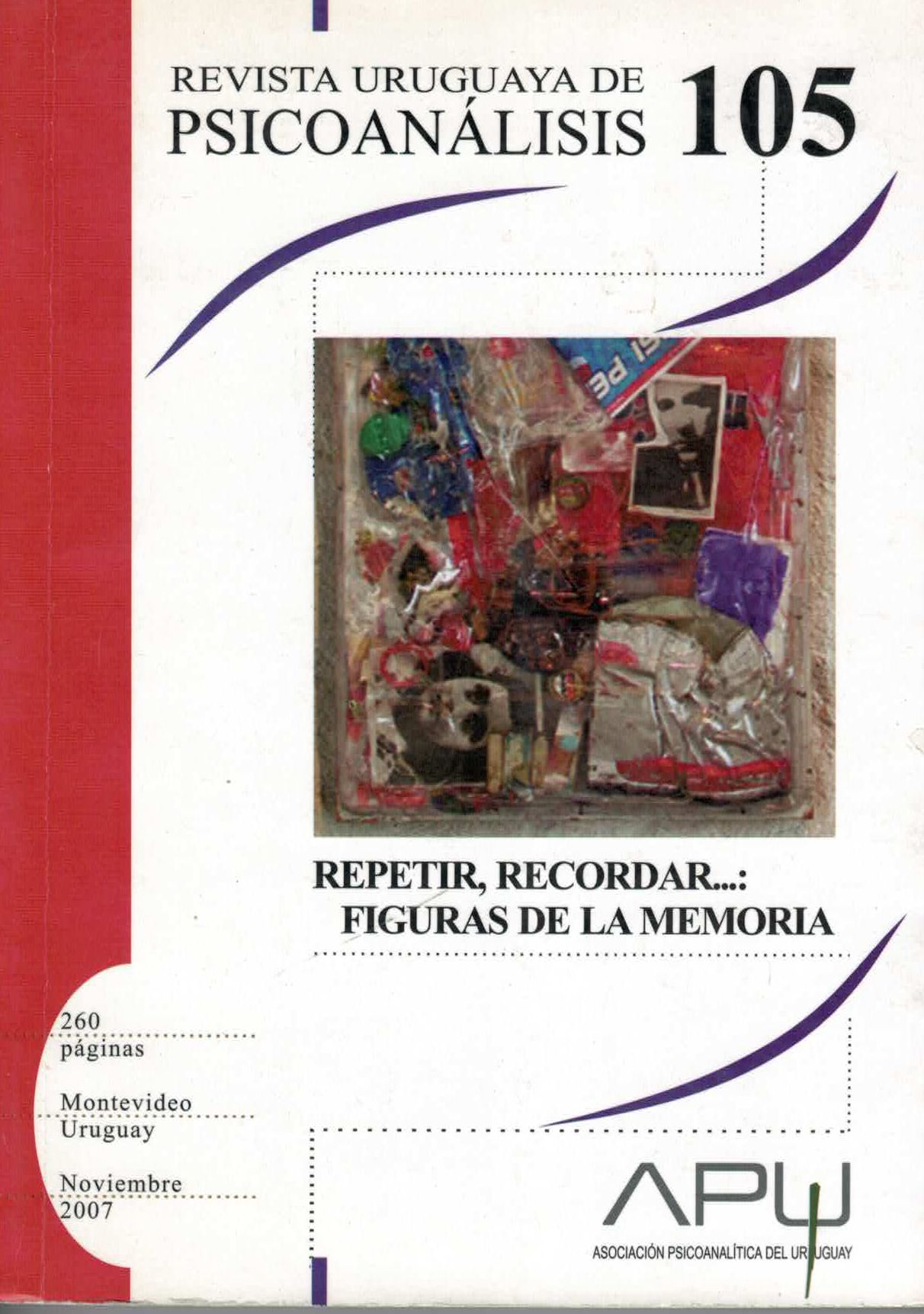Breaking the circle: lying and pretending as resistance against analysis, against life
Keywords:
mentalización, mentira, material clínicoAbstract
This paper will discuss ‘working through’ in terms of a model of the experience of psychic reality which Peter Fonagy and the
author have described in a series of papers entitled ‘Playing with Reality’. This model has been based on research evidence about
the development of symbolisation in the context of early attachment, as well as on clinical experience of adult and child
psychoanalysis. The suggestion is that the normal development of psychic reality involves integration of two initially split ‘modes’
of experiencing the relationship between mind and world: pretend and psychic equivalence modes. The capacity to integrate these
modes, to represent states of mind as such, to know them as fallible versions of inner or outer realities, is never fully achieved. Different types of untruth are explored in relation to normal development, in which lying is a more mature form than living in ‘pretend mode’. The psychoanalytic process is explored in terms of the protected separation of these two early modes of psychic reality. Working through is then the process of reintegration of experiences felt in
psychic equivalence, made safe to re-experience by the frame of analysis as a ‘pretend’ experience: outside the rules of normal
reality. Through disturbing thoughts, feelings and fantasies being suffered wih the literalness of early childhood, the analyst gains
access to increasingly deep unconscious levels of experience, all the time paying attention to maintaining the isolation of pretend mode from ordinary social implications. In different types of psychopathology there are stable,
characteristic distortions of the experience of psychic reality, which can in the case of different personality disorders be regarded as a hallmark, shaping the relational, behavioural and affective disturbances which define them. In the case of severe character
disturbance they also, it is suggested that psychoanalytic technique needs to be modified in the early stages to engage the patient
Rompiendo el círculo: mentir y aparentar como resistencia contra... effectively. In this paper, distortions in the experience of psychic
reality in highly narcissistic patients are considered in terms of a stable dissociation between pretend and psychic equivalent modes,
where the pretend mode is privileged and used to control the external social world, as a secret source of pleasure, to defend
against unbearable affects experienced in psychic equivalent mode, and/or to create the illusion of coherent self-experience. The
dissociation of these modes of experience of subjectivity is however hard to sustain particularly because others are required to collude. The precariousness of the solution threatens overwhelming the self with feelings such as intense dread, despair, hatred, self-hatred, loss of self, loneliness, and in some cases psychosomatic collapse. The early process of analysis, more confrontation with reality, and less retreat into a shared pretend mode, are necessary to engage the patient and get some traction into the process. After that, a more usual analytic technique becomes effective, whereas if used at the beginning it could become part of the patient’s false way of living and relating to self and others. This suggestion is illustrated by two cases in which parallel pretend worlds were seen as allowing the maintenance of an artificially fixed reality, in which other people’s minds were felt to be controlled. Working through first required the identification of each mode operating in life and in analysis: the dominant pretend state of mind (everything is possible in parallel, there are no contradictions or consequences), and the more hidden experience of psychic equivalence (I can make everything or nothing happen in reality, everyone’s mind is cont rolled by mine). Another aspect in the two cases was the uncovering by the analyst of a secret, more dissociated dimension
of ‘pretend’, the recognition and working through of which were crucial. The work involved noticing how the pull into ‘pretend’
constantly operated in the transference, blocking the experience of disturbing feelings with the immediacy of psychic equivalence,
and therefore blocking change. This required finding where pleasure and anxiety lay in that, and tracing how everything worked
on would be secretly cancelled out. Seeing a possibility of development and precisely negating it was a subtle pressure
towards collusion in the first case, but a pervasive, very perverse gratification in the second.
Enabling this endless holding pattern to be broken, allowing painful experiences to be felt as completely real, then working
them through to allow a more integrated sense of psychic reality, enabled both patients to engage more genuinely in analysis and to reduce the defensive need to multiply their external lives.
Downloads
References
BATEMAN, A. W. (1998). “Thick- and thin-skinned organisations and enactment in borderline and narcissistic disorders.” Int J Psychoanal,
, 13-25.
BION, W.R. (1962). The Psycho-Analytic Study of Thinking. Int. J. PsychoAnal., 43,306-310.
BRITTON, R. (1989). The Missing Link: Parental Sexuality in the Oedipus Complex. in The Oedipus Complex Today (ed. J.Steiner), London:
Karnac Books 83-101.
BRITTON, R. (1998). Belief and Imagination. London, Routledge.
(2007). Hyper-subjectivity versus Hyper-objectivity in Narcissistic Disorders. Public lecture given at the Institute of PsychoAnalysis, London, January 2007.
FONAGY, P., G. GERGELY, JURIST, E & TARGET M. (2002). Affect Regulation, Mentalization and the Development of the Self. New York,
Other Press.
FONAGY, P. AND M. TARGET (1996). “Playing with reality: I. Theory of mind and the normal development of psychic reality.” International
Journal of Psycho-Analysis, 77, 217-233.
(2000). Playing with reality. III: The persistence of dual psychic reality in borderline patients. International Journal of
Psychoanalysis, 81, 853-874.
(2007). “Playing with reality IV: A theory of external reality rooted in intersubjectivity”. International Journal of Psycho-Analysis.
JOSEPH, B. (1959). An Aspect of the Repetition Compulsion. Int. J.Psycho-Anal., 40, 213-222.
. (1982). Addiction to Near-Death. Int. J. Psycho-Anal., 63,449-456.
(1983). On Understanding and not Understanding: SomeTechnical Issues. Int. J. Psycho-Anal., 64, 291-298
LEMMA, A. (2005). The many faces of lying. Int. J. Psycho-Anal., 86,737-753
O’SHAUGHNESSY, E. (1990). Can a Liar be Psychoanalysed. Int. J.Psycho-Anal., 71, 187-195
(1992). Enclaves and Excursions. Int. J. Psycho-Anal.,73,603-611.
PARSONS, M. (2006). Raiding the Inarticulate: The Internal analytic setting and listening beyond countertransference. Paper given to the
English-Speaking Weekend Conference, London, October 2006.
REY, J.H. (1988). That which Patients Bring to Analysis. Int. J. PsychoAnal., 69, 457-470.
RICH, A. (1975) Women and Honor: Some Notes on Lying. In Rich, A. (1979) On Lies, Secrets and Silence.
RIVIERE, J. (1929). Womanliness as a Masquerade. Int. J. Psycho-Anal., 10, 303-31
ROSENFELD, H. (1987). Impasse and Interpretation. London, Tavistock Publications.
SEGAL, H. (1957). Notes on symbol formation. Int. J. Psychoanal. 38, 391-397.
(1978). On Symbolism. Int. J. Psycho-Anal., 59, 315-319.
STEINER, J. (1993). Psychic Retreats. London: Routledge.
TARGET, M. (in press). Is our sexuality our own? A developmental model of sexuality based on early affect mirroring. B. J. Psychotherapy.
TARGET, M. and P. FONAGY (1996). “Playing with reality II: The development of psychic reality from a theoretical perspective.”
International Journal of Psycho-Analysis, 77, 459-479.
TODD, OLIVIER (1996). Broadcast discussion of Todd’s definitive biography Albert Camus: Une Vie. Paris: Éditions Gallimard.
WINNICOTT, D.W. (1986). Holding and Interpretation. Int. Psycho-Anal. Lib., 115, 1-194.
(1971), Playing and Reality. Harmondsworth, UK: Pelican Books.










 This work is licensed under a
This work is licensed under a 